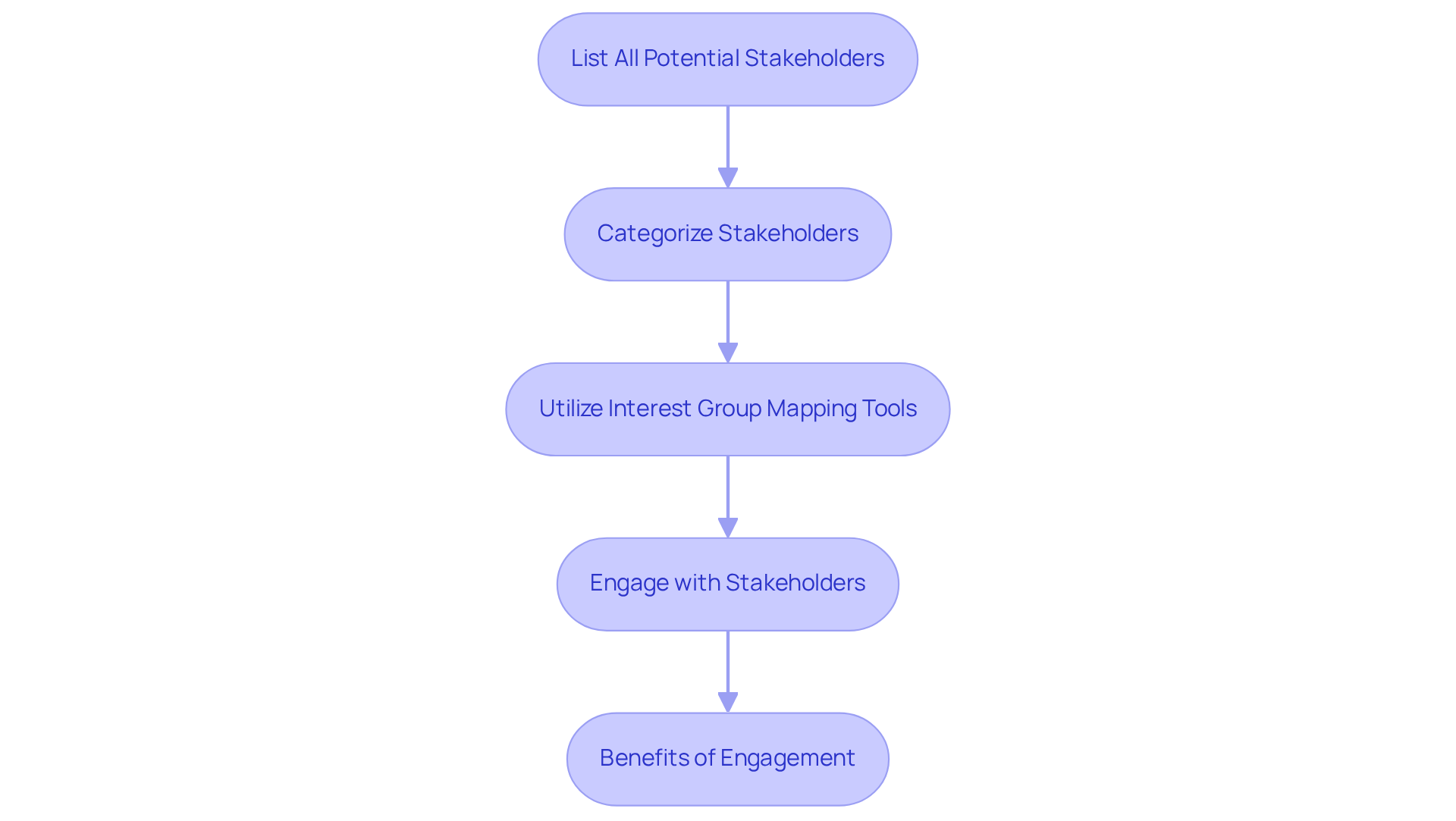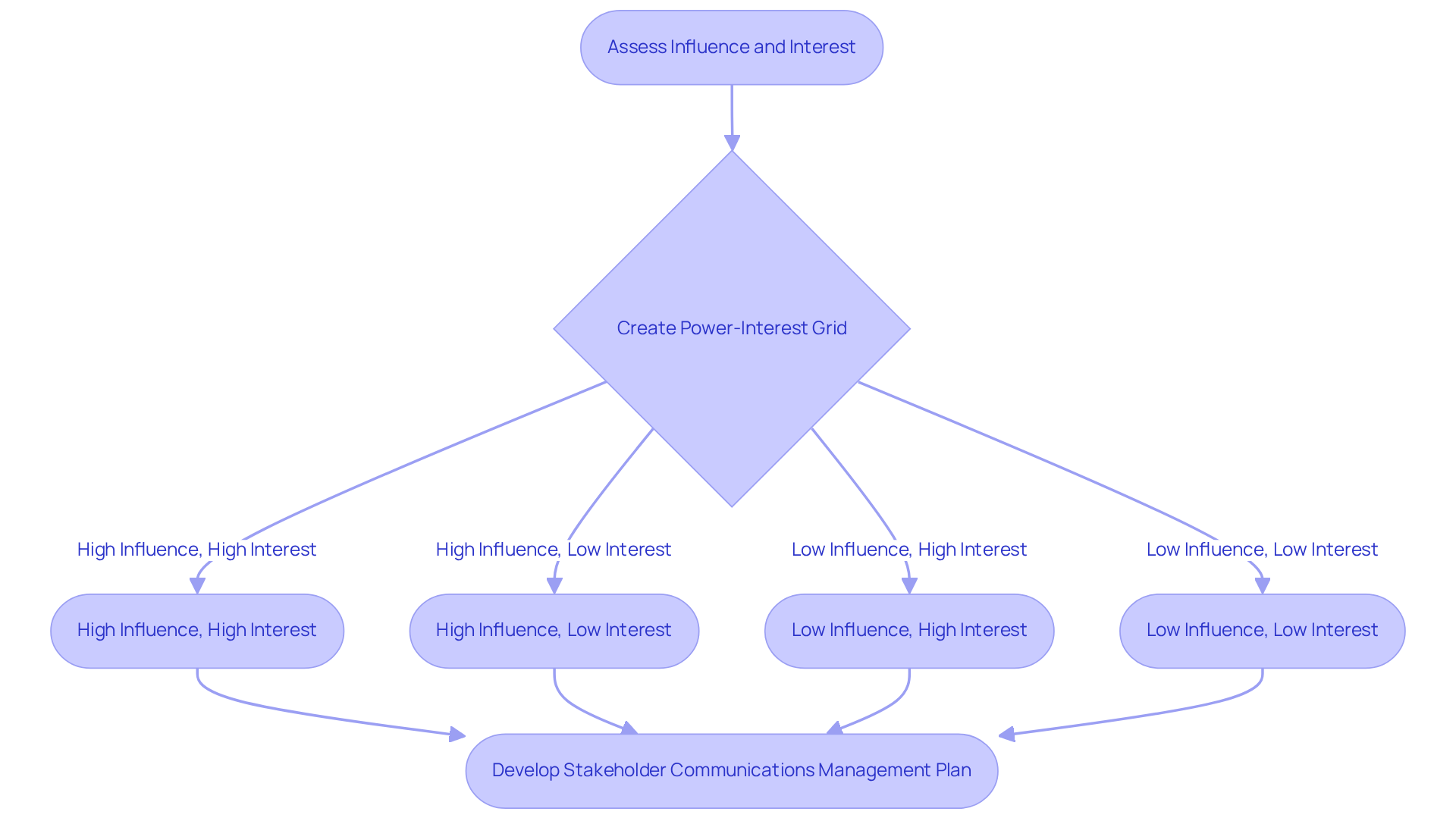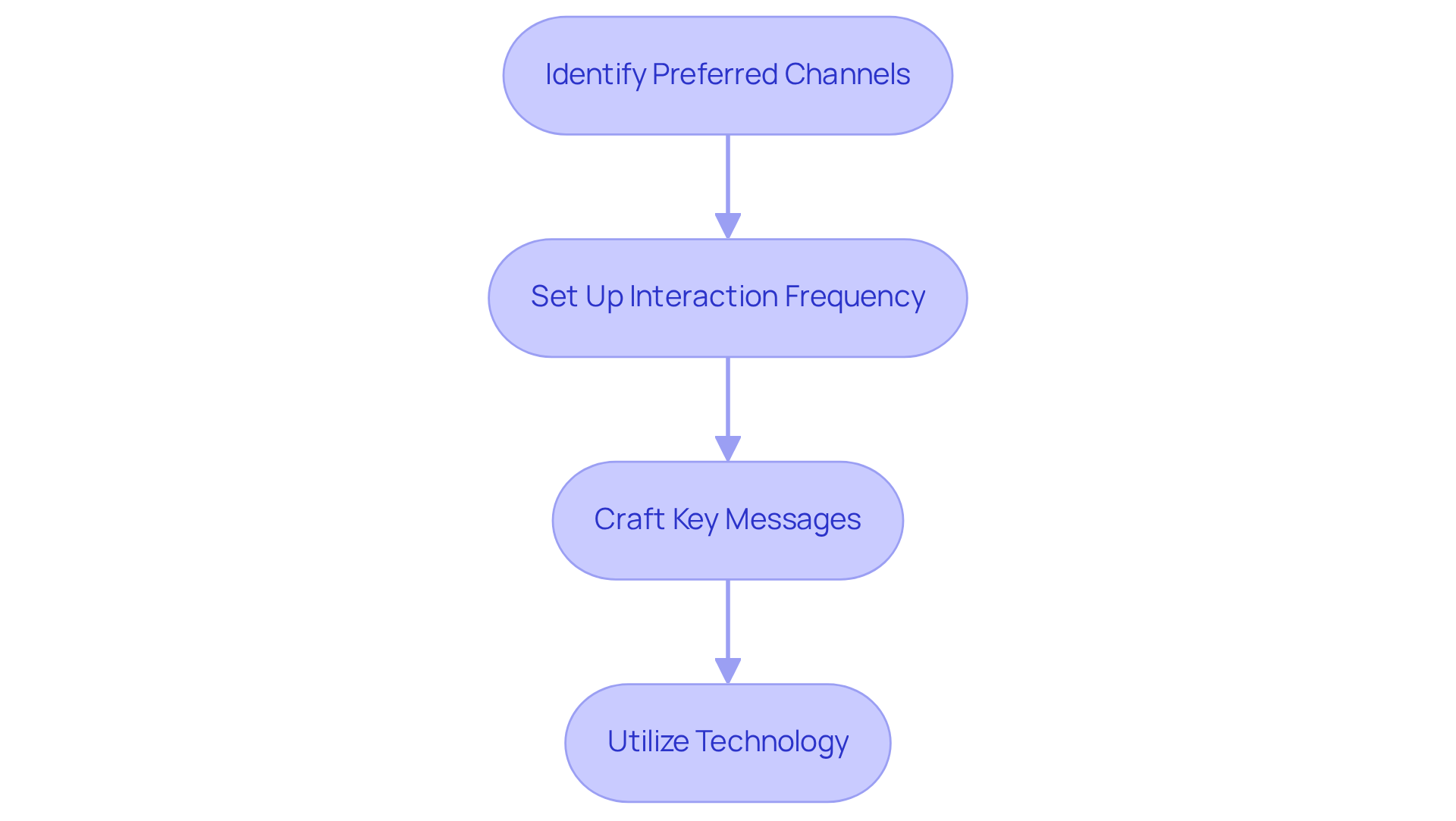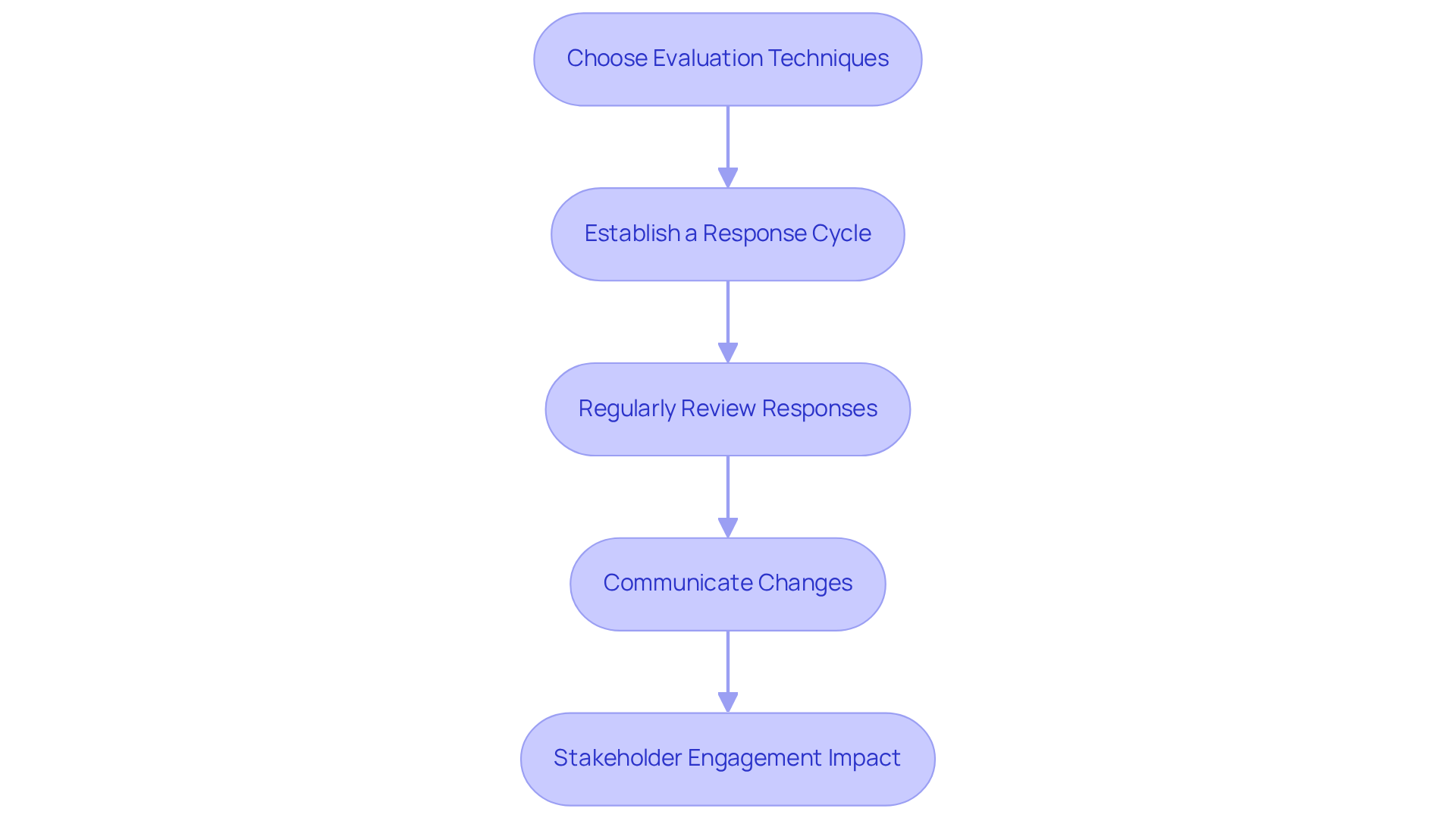Overview
The article emphasizes the creation of a stakeholder communications management plan, detailing essential steps for effectively identifying, prioritizing, and engaging stakeholders. It underscores the significance of tailored communication strategies and regular feedback mechanisms, which are pivotal in enhancing project success rates and stakeholder satisfaction. By implementing these strategies, organizations can cultivate stronger relationships with stakeholders, ultimately driving project success. Therefore, it is crucial to adopt a structured approach to stakeholder engagement, ensuring that communication is not only effective but also responsive to stakeholder needs.
Introduction
Crafting an effective stakeholder communications management plan is crucial for the success of any project, as it lays the groundwork for meaningful engagement and collaboration.
By identifying and prioritizing stakeholders, organizations can tailor their communications to meet diverse needs and expectations, ultimately driving better outcomes.
However, how can project leaders ensure that their strategies not only resonate with stakeholders but also adapt to their evolving concerns and interests?
This guide delves into the essential steps for developing a robust stakeholder communications plan that fosters ongoing dialogue and continuous improvement.
Identify Your Stakeholders
To effectively identify your stakeholders, follow these steps:
-
List All Potential Stakeholders: Begin by brainstorming all individuals, groups, and organizations that may be affected by your initiative. This includes both internal parties (employees, management) and external parties (customers, suppliers, community members).
-
Categorize Stakeholders: Group stakeholders based on their connection to the initiative. Common categories include:
- Primary Stakeholders: Those directly affected by the project outcomes.
- Secondary Stakeholders: Individuals indirectly impacted or who have an interest in the initiative.
- Key Stakeholders: Parties with significant influence or power over the project.
-
Utilize Interest Group Mapping Tools: Consider employing tools such as matrices or influence-interest grids to visualize and categorize interest groups effectively. Research indicates that organizations actively involving interested parties are 35% more likely to achieve their goals and objectives, underscoring the importance of this step.
-
Engage with Stakeholders: Conduct interviews or surveys to gather insights about their interests and concerns regarding the initiative. Involving interested parties early assists in identifying potential obstacles and ensuring their needs are addressed, resulting in smoother transitions and improved outcomes. Effective communication, as outlined in the stakeholder communications management plan, is paramount, as 85% of initiatives with high levels of participant involvement met or exceeded their original goals and objectives. Furthermore, firms that engage participants in decision-making are 30% more likely to achieve their objectives. As highlighted by industry specialists, "Effective engagement with interested parties was cited as a crucial factor in reducing failure rates of initiatives by as much as 50%." Regular updates and soliciting input from involved parties are essential strategies outlined in the stakeholder communications management plan to maintain engagement and address any issues promptly. Neglecting participant involvement can lead to significant risks, including delays and unmet goals.

Prioritize Stakeholders by Influence and Interest
To effectively prioritize your stakeholders, follow these essential steps:
-
Assess Influence and Interest: Evaluate each party based on their influence (the power to affect the project) and interest (the level of concern about project outcomes). Utilize a simple scale (high, medium, low) for both criteria to facilitate this assessment.
-
Create a Power-Interest Grid: Map individuals on a grid where one axis represents influence and the other represents interest. This visual tool aids in identifying which stakeholders require more focused attention:
- High Influence, High Interest: These stakeholders should be managed closely and kept well-informed to ensure their support. As noted, companies that interact with interested parties are 50% more likely to achieve their major objectives.
- High Influence, Low Interest: Keep these involved parties satisfied with periodic updates, but avoid overwhelming them with excessive information.
- Low Influence, High Interest: Engage and inform these participants regularly, as their enthusiasm can be beneficial to the project. Engaging essential employees in interest group involvement makes transformations four times more likely to succeed.
- Low Influence, Low Interest: Oversee these parties with minimal effort, ensuring they stay informed without overwhelming them with messages.
-
The stakeholder communications management plan outlines the strategies for effective communication with all involved parties. Develop engagement strategies by creating a stakeholder communications management plan that tailors your communication strategies based on the prioritization established in the grid. For high-priority participants, consider implementing more frequent updates and direct engagement methods. Barbara Kephart highlights that comprehending the needs of involved parties establishes the basis for trust, which is essential for efficient management. Conversely, for those with lower priority, less frequent communication may be sufficient, ensuring that their needs are still addressed without excessive resource allocation.
By employing these strategies, organizations can enhance relationships with interested parties and improve project outcomes, ultimately leading to greater success in achieving their objectives. Furthermore, incorporating feedback systems, such as participant forums, is crucial for continuous assessment of expectations and impact.

Define Communication Channels and Strategies
To effectively define your communication channels and strategies, consider the following steps:
- Identify Preferred Channels: Evaluate the favored methods of interaction for each group of interested parties. Common channels include email updates, meetings (in-person or virtual), newsletters, social media, and project management tools. Given that 39% of organizations prioritize hybrid models of work, it's essential to consider how these preferences may vary in a remote or hybrid environment.
- Set Up Interaction Frequency: Identify the frequency of interactions for each participant group. Key participants may gain from weekly updates, while others might only need monthly or quarterly reports. Research indicates that over 90% of employees desire weekly communication from their organizations, highlighting the need for regular engagement. Moreover, 73% of organizations that engage effectively with their interested parties are more likely to achieve their change management objectives as detailed in their stakeholder communications management plan.
- Craft Key Messages: Develop clear and concise messages tailored to the interests and concerns of each stakeholder group. Effective interaction can lead to an 18% increase in productivity and sales, making it essential to ensure that messages resonate with their specific needs. Recognizing achievements and addressing concerns is crucial, as Gallup found that the number one reason employees leave is a lack of recognition.
- Utilize Technology: Leverage technology to enhance interaction processes. Implement project management software that facilitates real-time updates and feedback, ensuring stakeholders remain informed and engaged. With the rise of remote work, tools that improve internal interactions have become increasingly essential, as 44% of employees express a desire for better interaction tools. Furthermore, 85% of employees feel more connected with effective communication, underscoring the importance of utilizing the right technology to foster engagement.
By following these steps, organizations can cultivate stronger connections with interested parties as part of their stakeholder communications management plan, ultimately driving successful project outcomes.

Implement Feedback Mechanisms for Continuous Improvement
To implement effective feedback mechanisms, follow these steps:
- Choose Evaluation Techniques: Select suitable approaches for collecting responses from interested parties. Options include surveys and questionnaires, one-on-one interviews, focus groups, and feedback forms after meetings.
- Establish a Response Cycle: Create a structured process for collecting, analyzing, and addressing input. Ensure involved parties understand how their input will be utilized to enhance the project, fostering a sense of ownership and involvement.
- Regularly Review Responses: Schedule consistent intervals (e.g., monthly or quarterly) to assess responses and evaluate the effectiveness of communication strategies. Modify your strategy according to feedback from involved parties to guarantee coherence with their needs and expectations. Recognizing the challenges organizations encounter in executing ongoing evaluations efficiently can ready CFOs for possible hurdles.
- Communicate Changes: Notify interested parties about the modifications made based on their suggestions. This not only demonstrates that their input is valued but also encourages ongoing participation, reinforcing a culture of collaboration and continuous improvement. As Gallup states, "Feedback should be a common occurrence -- for most jobs, a few times per week."
Effective stakeholder engagement can significantly impact project success; studies show that projects with a stakeholder communications management plan succeed 83% of the time, compared to only 32% for those lacking such strategies. By prioritizing response systems, organizations can enhance relationships, improve satisfaction, and ultimately drive better outcomes. Additionally, adopting a 'Fast Feedback' approach can simplify the feedback process for managers, making it easier to implement these strategies in practice.

Summarize Key Components for Clarity and Consistency
To effectively summarize the key components of a stakeholder communication plan, consider the following steps:
- Develop a Messaging Plan Document: Combine all components of your messaging strategy into a comprehensive document. This should encompass sections on participant identification, prioritization, information channels, feedback methods, and key messages.
- Distribute the Plan: Ensure that the communication plan is shared with all parties involved, making them aware of the strategies in place. This can be accomplished through email or during a dedicated meeting, fostering transparency and engagement.
- Reinforce Key Messages: Regularly revisit and emphasize the key messages throughout the initiative lifecycle. Consistent reinforcement aids in sustaining attention and alignment among involved parties, which is essential for achieving success.
- Encourage Ongoing Dialogue: Cultivate an environment where participants feel comfortable voicing their concerns and suggestions. This ongoing conversation is vital for fostering strong connections and ensuring the initiative's success. Involved parties are more inclined to make positive contributions, as efficient interaction can enhance productivity by as much as 25%.
By implementing these strategies, organizations can enhance their stakeholder communications management plan, leading to improved collaboration and project outcomes.

Conclusion
A well-crafted stakeholder communications management plan is essential for successful project execution. By systematically identifying, prioritizing, and engaging stakeholders, organizations can foster strong relationships that contribute to achieving project objectives. This approach not only ensures that all parties are informed and involved but also minimizes risks associated with neglecting stakeholder needs.
Moreover, throughout the article, key strategies were highlighted, including:
- The importance of categorizing stakeholders
- Utilizing power-interest grids for prioritization
- Defining effective communication channels
- Implementing feedback mechanisms
Each of these components plays a critical role in enhancing stakeholder engagement and satisfaction, ultimately leading to improved project outcomes. The evidence presented underscores that organizations that prioritize stakeholder communication are significantly more likely to succeed in their initiatives.
In summary, investing time and resources into developing a robust stakeholder communications management plan can yield substantial benefits. Organizations are encouraged to adopt these best practices to not only meet project goals but also to cultivate a culture of collaboration and continuous improvement. By recognizing the pivotal role that effective stakeholder communication plays in project management, organizations can position themselves for long-term success and resilience in an ever-evolving landscape.
Frequently Asked Questions
What is the first step in identifying stakeholders for a project?
The first step is to list all potential stakeholders by brainstorming individuals, groups, and organizations that may be affected by the initiative, including both internal parties (like employees and management) and external parties (such as customers and suppliers).
How can stakeholders be categorized?
Stakeholders can be categorized into three common groups: Primary Stakeholders: Those directly affected by the project outcomes. Secondary Stakeholders: Individuals indirectly impacted or who have an interest in the initiative. Key Stakeholders: Parties with significant influence or power over the project.
What tools can be used to map stakeholders?
Interest group mapping tools such as matrices or influence-interest grids can be utilized to visualize and categorize interest groups effectively.
Why is stakeholder engagement important?
Engaging stakeholders through interviews or surveys helps gather insights about their interests and concerns, which can identify potential obstacles and ensure their needs are addressed, leading to smoother transitions and improved outcomes. High levels of participant involvement significantly increase the likelihood of meeting project goals.
How should stakeholders be prioritized?
Stakeholders should be prioritized based on their influence (the power to affect the project) and interest (the level of concern about project outcomes), using a simple scale of high, medium, or low for both criteria.
What is a Power-Interest Grid?
A Power-Interest Grid is a visual tool that maps stakeholders based on their influence and interest levels, helping to identify which stakeholders require more focused attention.
What strategies should be used for high influence, high interest stakeholders?
High influence, high interest stakeholders should be managed closely and kept well-informed to ensure their support, as their engagement is crucial for achieving major objectives.
How should low influence, high interest stakeholders be managed?
Low influence, high interest stakeholders should be engaged and informed regularly, as their enthusiasm can be beneficial to the project.
What role does a stakeholder communications management plan play?
A stakeholder communications management plan outlines strategies for effective communication with stakeholders based on their prioritization, ensuring that engagement strategies are tailored to the needs of each group.
How can organizations improve relationships with stakeholders?
Organizations can enhance relationships with stakeholders by employing effective communication strategies, engaging participants regularly, and incorporating feedback systems such as participant forums for continuous assessment of expectations and impact.




